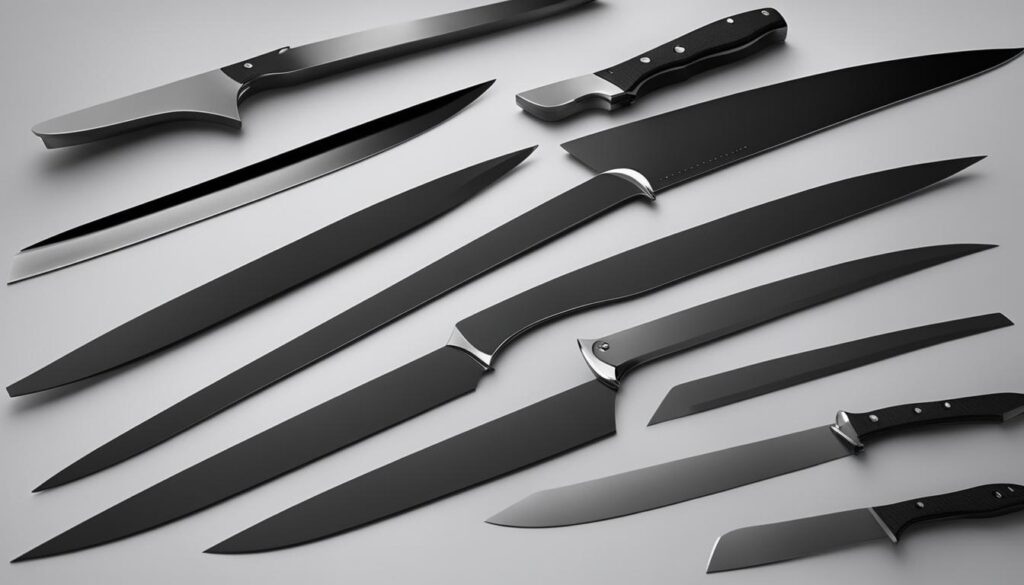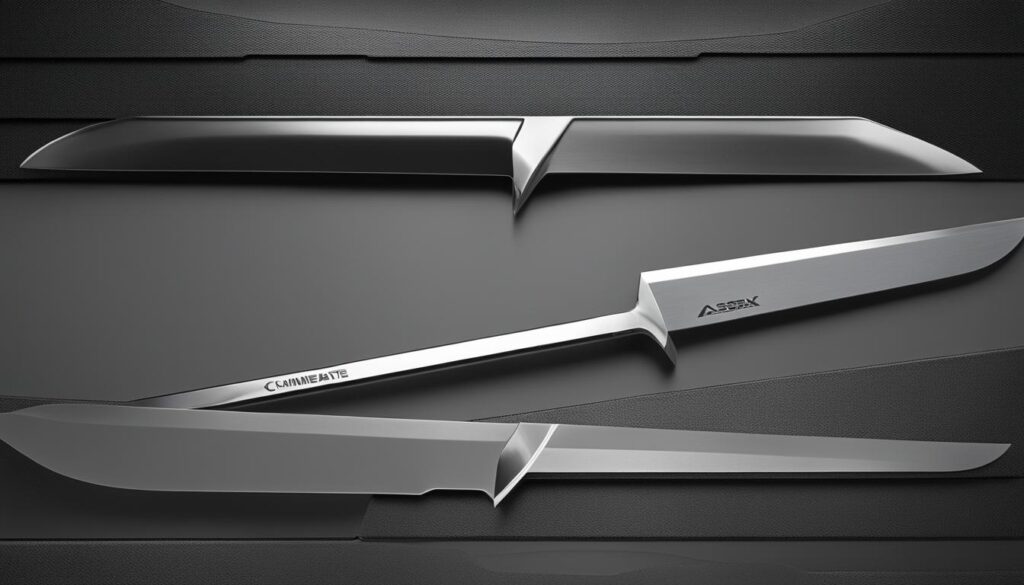A knife’s blade shape is more than just an aesthetic feature – it plays a crucial role in its performance. Different blade shapes have different strengths and weaknesses, and understanding them can help you choose the perfect hunting knife. The blade length is a key factor that directly impacts cutting efficiency. By exploring the relationship between blade length and cutting efficiency, you can make an informed decision when selecting a hunting knife.
Key Takeaways:
- Blade length is a critical factor that affects a hunting knife’s cutting efficiency.
- Understanding different blade shapes can help you choose the right hunting knife.
- Common blade shapes have specific uses and benefits for various tasks.
- Specialized blade shapes offer unique functionalities for specific hunting situations.
- Drop point blades are versatile and widely regarded as an excellent choice for hunting knives.
Blade Shape Basics: The Heart of a Knife
When it comes to choosing the perfect hunting knife, one of the most important factors to consider is the blade shape. The blade shape is the defining characteristic of a knife and plays a significant role in determining its strengths, weaknesses, and overall performance. Understanding the basics of blade shape is essential for selecting a hunting knife that meets your specific needs.
Several factors contribute to the performance of a knife’s blade shape. Blade geometry, cutting edge dynamics, and symmetry all play a role in how a knife functions. Different blade shapes are designed to excel in specific tasks, such as slicing, piercing, or precise control. By considering these factors, you can choose a knife that aligns with your intended use.
It is important to note that each blade shape has its own unique purpose and benefits. For example, a straight-edge blade offers precise control, making it ideal for carving or slicing tasks. On the other hand, curved blades are great for slicing with a rocking motion, making them perfect for field dressing during hunting trips.
By understanding the different blade shapes and their strengths and weaknesses, you can make an informed decision when selecting a hunting knife that will perform optimally for your intended tasks.
Table: Common Blade Shapes and Their Uses
| Blade Shape | Strengths | Weaknesses | Uses |
|---|---|---|---|
| Straight Edge | Precise control | Less versatile in certain tasks | Carving, slicing |
| Curved | Efficient slicing with rocking motion | Less control for push cuts | Field dressing |
| Tanto | Strong tip for piercing | Less effective for slicing | Tactical applications |
“Understanding the different blade shapes and their strengths and weaknesses is crucial for finding the perfect hunting knife that suits your needs.”
By exploring the various blade shapes and their specific uses, you can confidently select a hunting knife that will excel in the tasks you require. Remember to consider the strengths and weaknesses of each blade shape, as well as the intended use, to ensure optimal performance in the field.
Common Blade Shapes and Their Uses
When choosing a hunting knife, it’s essential to understand the different blade shapes and their specific uses. Each blade shape offers unique advantages and is designed to excel in certain tasks. By familiarizing yourself with these common blade shapes, you can select a hunting knife that suits your needs.
Straight Edge Blades
Straight edge blades have a flat cutting edge and offer precise control for push cuts. This makes them ideal for carving, slicing, and other tasks that require accuracy. Straight edge blades are commonly found in hunting knives used for field dressing and food preparation.
Curved Blades
Curved blades feature a slight curve along the cutting edge, allowing for a rocking motion while slicing. This design is especially useful for hunters who need to perform field dressing, as it allows for smooth and efficient skinning. Curved blades are also excellent for cutting ropes, cords, and other materials.
Tanto Blades
Tanto blades have a strong and robust design with a high point and a flat grind. They are known for their excellent piercing capabilities and are commonly found in tactical knives. Tanto blades are ideal for tasks that require strength and precision, such as puncturing tough materials or performing intricate cutting.
Drop Point Blades
Drop point blades are versatile and widely used in hunting knives. They feature a slightly convex curve along the cutting edge, leading to a robust tip and a large belly. This design offers excellent slicing capabilities and provides added strength for puncturing tasks. Drop point blades are suitable for a wide range of hunting and outdoor activities.

| Blade Shape | Uses |
|---|---|
| Straight Edge | Carving, slicing, precise cuts |
| Curved | Field dressing, skinning, cutting ropes |
| Tanto | Piercing, tough materials, intricate cutting |
| Drop Point | Slicing, puncturing, versatile use |
Specialized Blade Shapes for Unique Tasks
When it comes to choosing a hunting knife, there are specialized blade shapes that offer unique functionality for specific tasks. These blades are designed to excel in certain areas, making them ideal for hunters looking to enhance their performance in unique situations. Let’s take a closer look at three popular specialized blade shapes: the Bowie, Dagger, and Hawksbill.
Bowie Knife
The Bowie knife, made famous by James Bowie in the 19th century, is a versatile blade that features a large belly and a sharp point. Its unique shape makes it ideal for slicing tasks, while the sharp point allows for precise piercing. The Bowie knife is a favorite among hunters who prioritize both cutting and piercing capabilities.
Dagger Blade
The Dagger blade is another specialized shape that excels in precision tasks. This blade features a double-edged design with a sharp point, allowing for excellent piercing capabilities. The Dagger blade is perfect for hunters who require precision in their cutting tasks, such as field dressing or intricate work.
Hawksbill Blade
The Hawksbill blade is characterized by its distinct inwardly curved edge. This shape offers exceptional cutting performance when it comes to cords, ropes, and other materials that require a slicing motion. The sharp, curved edge of the Hawksbill blade ensures efficient cutting, making it a valuable tool for hunters dealing with various materials in the field.
These specialized blade shapes provide unique advantages for specific hunting tasks. Whether you need a knife for slicing, piercing, or precision work, understanding the capabilities of these blades can help you choose the right tool for the job.


| Blade Shape | Main Features | Tasks |
|---|---|---|
| Bowie | Large belly, sharp point | Slicing, piercing |
| Dagger | Double-edged, sharp point | Precision tasks, field dressing |
| Hawksbill | Inwardly curved edge | Cutting cords, ropes, slicing |
The Versatility of Drop Point Blades
The drop point blade shape is widely regarded as one of the best designs for a hunting knife due to its versatility. Its unique features make it highly suitable for a variety of tasks. The drop point blade is characterized by a convex curve on the back of the blade, which makes the tip lower than the spine. This design creates a large belly for efficient slicing and a sharp enough tip to handle finer tasks effectively.
A key advantage of the drop point blade is its robust tip. The thick, strong tip provides added strength during puncturing tasks, making it ideal for tasks such as field dressing or piercing tough materials. The broad, straight cutting edge of the drop point blade offers easy control over cuts, making it versatile for various cutting techniques. This allows hunters to perform a wide range of tasks, from basic slicing to more intricate movements.
Drop point blades are commonly found on hunting knives, pocket knives, and tactical knives. The versatility of the drop point shape makes it a popular choice among hunters and outdoor enthusiasts. Whether you need to skin an animal, perform detailed tasks like carving, or even use the knife for self-defense purposes, the drop point blade can handle it all. Its combination of efficient slicing capabilities, strong tip, and easy control make it an excellent all-purpose blade for hunters.
Benefits of Drop Point Blades for Hunting
- Versatile cutting: The drop point shape allows for versatility in cutting techniques, making it suitable for a wide range of hunting tasks.
- Efficient slicing: The large belly of the drop point blade enables efficient slicing, making it easier to process game meat.
- Strong tip: The robust tip of the drop point blade provides added strength for puncturing tasks and field dressing.
- Easy control: The broad, straight cutting edge offers easy control and precision during cuts, enhancing overall performance.
Conclusion
After examining the impact of blade length on cutting efficiency, it is clear that this factor plays a crucial role in selecting the perfect hunting knife. The length of a blade directly affects its cutting capabilities, making it an essential consideration when making a decision. By understanding the relationship between blade length and cutting efficiency, hunters can choose a knife that meets their specific needs.
In addition to blade length, other factors such as blade shape also contribute to the performance and versatility of a hunting knife. Specialized blade shapes, like the Bowie, Dagger, and Hawksbill, offer unique functionalities for specific tasks. On the other hand, drop point blades are widely regarded for their versatility, with a large belly for slicing and a sharp tip for finer tasks.
By considering both blade length and shape, hunters can find the perfect knife that enhances their cutting efficiency and meets their unique requirements. Whether it’s for field dressing, carving, or slicing, understanding these aspects will lead to an informed decision when selecting a hunting knife.
FAQ
Why is blade shape important when choosing a hunting knife?
Blade shape determines the strengths, weaknesses, and overall performance of a knife. Different shapes excel in different tasks, so understanding blade shape is essential for choosing the right hunting knife.
What are some common blade shapes and their uses?
Straight edges are ideal for precise control in push cuts, while curved blades are great for slicing with a rocking motion. Other common blade shapes include tanto, clip point, and drop point, each with their own unique uses.
Are there specialized blade shapes for specific tasks?
Yes, specialized blade shapes like the Bowie, dagger, and hawksbill offer unique functionalities. The Bowie knife is known for its large belly and sharp point, while dagger blades are designed for precision and piercing capabilities. Hawksbill blades excel at cutting cords and ropes.
Why is a drop point blade shape versatile for hunting knives?
Drop point blades have a large belly for efficient slicing and a strong tip for puncturing tasks. The broad straight cutting edge allows for easy control over cuts. They are commonly found on hunting knives, pocket knives, and tactical knives.
How does blade length impact cutting efficiency?
Blade length directly affects a knife’s cutting capabilities. Longer blades can make deeper and longer cuts, while shorter blades offer increased control and maneuverability. Understanding this relationship is crucial for selecting the right hunting knife.
Source Links
- https://heinnie.com/blog/decoding-blade-shape-your-guide-to-knife-efficiency/
- https://www.mapquest.com/travel/outdoor-activities/hunting/traditional-methods/how-to-choose-hunting-knife.htm
- https://texanknives.com/from-field-to-feast-the-ultimate-guide-to-choosing-the-right-knife-for-your-outdoor-adventure/





